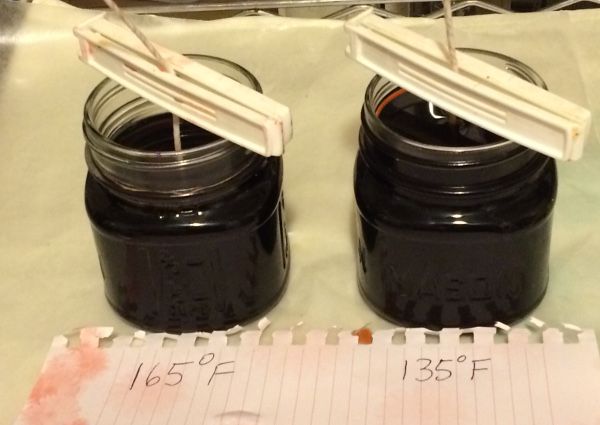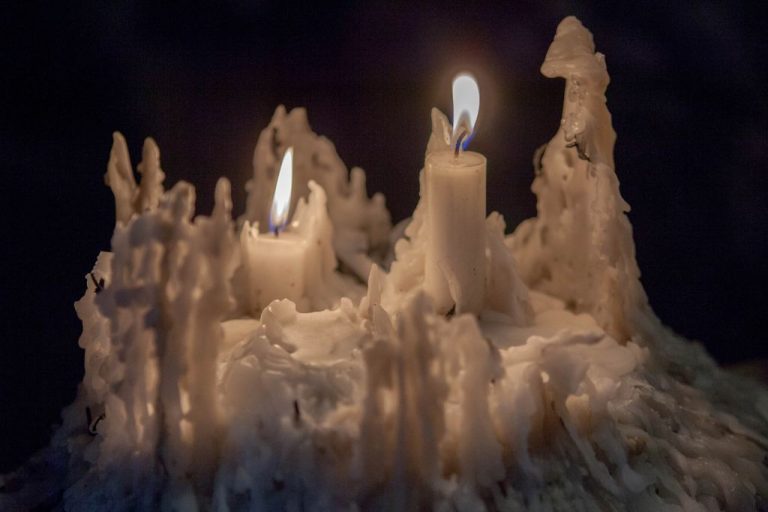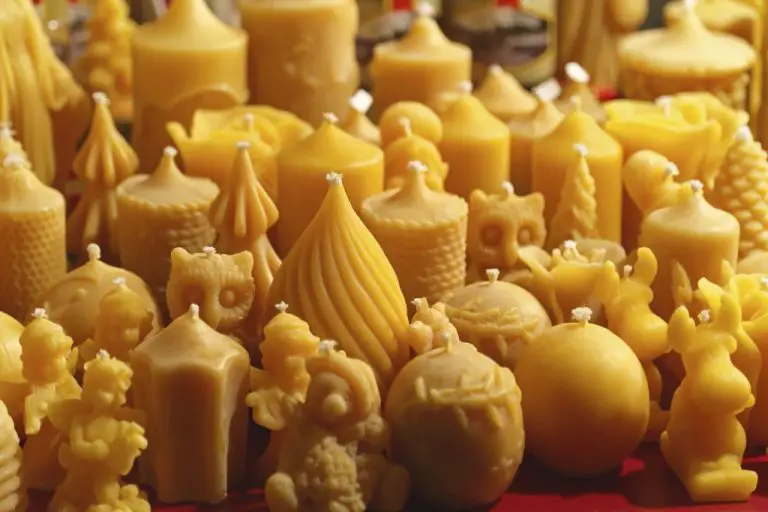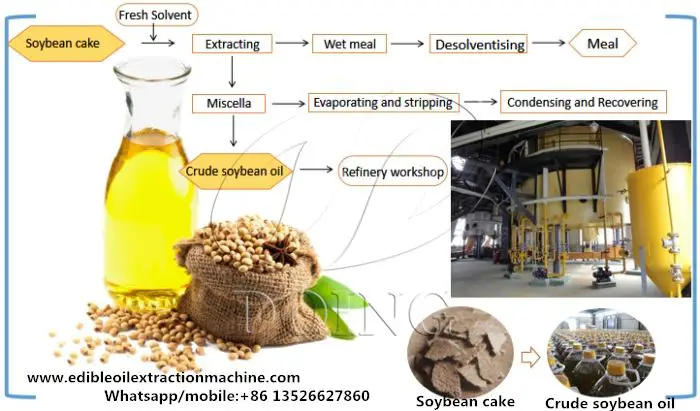What Happens To Candle Wax When It Melts?
Candles have been used for light and ambiance for centuries. They are made by embedding a wick in wax, often paraffin wax or beeswax. When lit, the wick burns and melts the surrounding wax. The melted wax is then drawn up the wick through capillary action and vaporized by the flame to produce light. This melting process is an interesting chemical reaction that affects the candle’s burn time, safety, and cleanup.
Chemical Composition
The chemical composition of candle wax varies depending on the type of wax used. Here are some of the most common types of waxes and their composition:
Paraffin Wax
Paraffin wax is a byproduct of petroleum refining. It consists of a mixture of hydrocarbon molecules, containing anywhere from 20 to 40 carbon atoms per molecule. The molecules are straight chains of hydrocarbons, which gives paraffin wax its crystalline structure and high melting point.
Soy Wax
Soy wax is made from hydrogenated soybean oil. It consists mainly of triglycerides, which are esters derived from glycerol and long-chain fatty acids. The fatty acids in soy wax have carbon chain lengths of 16-18 atoms. Soy wax has a lower melting point than paraffin wax.
Beeswax
Beeswax is produced by honey bees. It contains a mixture of over 300 chemical compounds, predominantly palmitate, palmitoleate, and oleate esters of long-chain fatty alcohols. It also contains some hydrocarbon compounds along with fatty acids and alcohols. The composition varies depending on the geographic origin of the beeswax.
Melting Point
The temperature at which a candle’s wax melts depends on the type of wax used. Beeswax, for example, has a melting point of 62-65°C (144-149°F). Paraffin wax, commonly used in candlemaking, melts between 47-65°C (117-149°F). Soy wax melts at 57-60°C (135-140°F). Palm wax has a melting point of 53-62°C (127-144°F).
The melting point is significant because the wax needs to be hot enough to melt and form a liquid pool into which the wick can be placed. But the wax cannot be so hot that it releases volatile organic compounds or presents a burn risk. Different waxes are blended by manufacturers to achieve an ideal melting temperature for candlemaking.
Melting Process
When a candle is lit, the flame provides heat that is absorbed by the solid wax. As the wax absorbs this heat energy, the kinetic energy of the molecules increases until the melting point is reached. At this point, the orderly structure of the solid wax breaks down as the molecules gain enough energy to move freely.
The wax then undergoes liquefaction, transitioning from a solid state to a liquid state. The increased molecular motion overcomes the intermolecular attractive forces that kept the wax rigid, allowing the molecules to move past one another and flow. This liquefied wax is then drawn up the wick by capillary action to fuel the flame as the candle continues to burn.
Wick Interaction
The wick of a candle is a specially designed string that interacts with melted wax. As the candle burns and wax melts, liquid wax is absorbed into the wick via capillary action. Capillary action refers to the ability of a liquid to flow upward in narrow spaces, which allows the melted wax to be drawn up into the wick.
The wick is often made from materials like cotton that have lots of tiny spaces between the fibers. These spaces act like capillary tubes, allowing the liquid wax to be pulled up. The wax travels up the wick, and is then vaporized at the tip by the flame. This creates a continuous fuel supply to the flame as long as melted wax is available.
Wick design is an important factor for proper candle burning. An appropriately sized wick with adequate capillary action helps ensure good wax flow to the flame. Too small of a wick can limit fuel supply and lead to tunneling, while too large of a wick can cause smoke and a hot flame. Proper wick interaction with melted wax keeps the candle burning evenly.
Re-solidification
As wax melts from its original solid form into a liquid, the process can be reversed as the wax cools. The melted wax will begin to solidify again if the temperature drops below the melting point. For example, paraffin wax has a melting point of around 47°C to 64°C. If liquid paraffin wax cools to 46°C or below, it will start reverting back from its liquid state to a solid state.
The re-solidification process happens because as the liquid wax cools, the molecules lose energy and move around less. The molecules begin to arrange themselves into a rigid structure again, forming crystalline solids. The wax transitions from having fluid properties back to solid properties. Factors like the cooling rate and presence of impurities can influence the structure and texture of the re-solidified wax.
As the wax re-solidifies, it can adhere back onto the wick or sides of the candle container. The wax may shrink in volume slightly as it solidifies. If the wax cooled in an irregular pool or puddle, it will maintain that shape when re-solidified. In summary, the reversible process allows melted candle wax to return to a solid state when it loses heat energy and drops below its melting point temperature.
Safety
Melted wax can cause serious burns if mishandled. The wax itself reaches temperatures over 180°F when lit, which is hot enough to cause third degree burns almost instantly. Even after blowing a candle out, recently melted wax can remain over 140°F and cause severe burns if spilled on skin.
To prevent burns, be very careful handling candles that have been lit for more than a few minutes. The melted wax pool will retain high temperatures that can burn skin quickly if contacted. Allow the wax to fully re-harden before moving or touching the candle. Never tilt or carry a burning candle, as hot wax may spill out. Keep burning candles on stable, heat-resistant surfaces and out of reach from children and pets.
If a burn does occur from spilled wax, run cool water over the area for 10-20 minutes. Do not attempt to peel solidified wax off skin, as it can tear skin. Seek medical attention for any wax burns that blister, swell extensively or cover a large area. Be very careful not to knock over burning candles to avoid potentially disfiguring burns.
Cleaning Up Melted Wax
Cleaning up spilled melted candle wax can be tricky, but there are some effective methods to remove it.
First, act quickly while the wax is still warm and pliable. Scrape off any large chunks of wax with a plastic spatula or butter knife and dispose of them. Then take some paper towels and blot at the remaining wax to absorb as much as possible.
Next, place a brown paper bag or newspaper over the wax spot and iron it on a medium-high setting. The paper will absorb the melted wax. Replace the paper as needed and repeat this process until no more wax transfers onto the paper.
If there is any wax left over, make a paste with equal parts baking soda and water. Gently spread the paste over the wax and let it sit for 15-20 minutes. Then wipe clean with a damp sponge or cloth. The paste will help lift the wax from the surface.
You can also try rubbing the area with an ice cube to harden the wax so it chips off more easily. Or use a hair dryer to re-melt the wax and blot it up with paper towels.
With some elbow grease, these techniques should effectively remove dried and liquefied wax from surfaces. Acting quickly is key to minimizing staining and getting spilled wax under control.
Environmental Impact
The environmental impact of candle wax depends on the type of wax used. Paraffin wax, a petroleum byproduct, raises some concerns while natural waxes like soy, beeswax, and palm wax are more eco-friendly.
Paraffin wax is derived from crude oil refining, so burning candles made from it releases compounds that can be harmful to human health and the environment. However, paraffin itself is chemically inert and not toxic. The soot it produces when burned can dirty the air.
Natural waxes like soy, beeswax, and palm wax have less environmental impact. Soy wax is made from soybean oil, a renewable resource. Beeswax is a natural secretion from honeybees that does not require refining. Palm wax comes from oil palm trees and is considered sustainable when responsibly sourced.
Compared to paraffin, natural waxes burn cleaner and release fewer harmful fumes into the air. They are often biodegradable too. However, some raise concerns over palm oil production practices. Overall, natural waxes are the more eco-friendly option.
When buying candles, consider the type of wax, especially if environmental impact is a concern. Natural waxes like soy and beeswax are better for the environment while paraffin may have more emissions and waste byproducts.
Conclusion
In summary, when candle wax melts it undergoes a physical change from solid to liquid state. The wax is composed of hydrocarbons that have a melting point around 150-200°F. As heat is applied, the wax molecules gain energy and break out of their rigid crystal structure to flow freely. The melted wax is then absorbed into the candle wick through capillary action, fueling the flame as it burns. The wax can resolidify into its original form if cooled below its melting point. Safety precautions should be taken with burning candles to prevent spills, house fires, and inhalation of smoke. Properly cleaning melted wax while hot makes it easier to remove. Overall, candle wax melting is a common phenomenon that provides illumination, though it does generate some emissions that can impact indoor air quality. With care, candles can be used safely without significant environmental harm. This covers the key points about what happens when candle wax melts.





